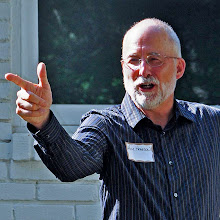This afternoon Judy and I made the trek into Charlotte to hear a performance by Joshua Bell, accompanied by Jeremy Denk. There are several things that might be said about this: that their performance was first rate (I only nodded once, for a split second); that they all but filled the hall, which almost never happens with the bluehairs of the Carolinas Concert Association; or that the program notes were downright bizarre in places, as for example in the following regarding the Concert Piece for Violin and Piano by Edgar Meyer: "Mr. Meyer is a frequent partner of Mr. Bell in the arcane (?!) art of bluegrass music, and perhaps this is the reason the violinist felt the need to introduce this work" (my, aren't we condescending).
But what struck me was the applause.
First on the program was Robert Schumann's Sonata No. 1 for Violin and Piano in a, Opus 105. A sizeable number of the audience applauded lustily after each movement. Beethoven's Sonata No. 10 for Violin and Piano in G, Opus 96, followed. The audience applauded after the first, third and fourth movements. No doubt they would have applauded after the second as well, but there is no break between the second and third movements.
After intermission, the duo played the piece by Edgar Meyer (a serious contemporary work in which one would have had to listen very hard to hear even a passing reference to bluegrass, by the way), and their was no applause between movements, but lusty applause with bravos and a standing O at the end.
I saw some of the bluehairs around me wincing at the applause in the "wrong" places. And I wondered, What's going on here? Did these two rock stars of classical music attract a group of relative youngsters who haven't been properly trained (indoctrinated?) in classical music etiquette? And yet, how to explain the lack of applause during the Meyer? At first I thought it might signal dislike, but the enthusiastic response at the end of the piece put that idea to rest.
Actually, I can't escape the suspicion that this untrained audience responded the way the composers themselves intended. The applause-provoking movements of the Schumann and the Beethoven ended with dramatic flourishes and a full stop. How could you write such an ending to a section and not expect people to react? The oddity to me is not that people would applaud at such a point, but that they wouldn't. When Beethoven didn't want applause, he made an entirely different type of transition between movements.
As for Edgar Meyer, each movement save the fourth of today's piece ended quietly, almost tentatively -- seemingly reaching out toward the next. Applause would have seemed strange, had there been any.
My conclusion is that this audience, or at least the "untrained" members, understood with their guts what's been bled out of concert goers for many decades -- that the composer and the artists are putting on a show, and they jolly well want you to enjoy it. If you are moved to demonstrations of enthusiasm, who's to say that's a bad thing? Lord knows, classical music needs all the enthusiasm anyone can muster these days.
Oh, and one other thing: Jeremy Denk has a great blog called Think Denk. Have a look.
Sunday, February 11, 2007
Subscribe to:
Post Comments (Atom)

No comments:
Post a Comment